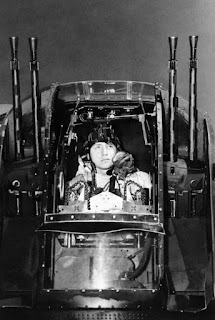One eventful sortie to Berlin in February was undertaken by
the crew of Flight Lieutenant Thomas Blackham of No.50 Squadron.
Over western Germany the bomber
was subjected to anti aircraft fire that came without searchlights, and was
presumably aimed by radar. One shell damaged the elevators, but the bomber was
otherwise untouched. A few minutes later a nightfighter that nobody on the
Lancaster ever saw opened fire and bullets riddled the rear part of the bomber.
The rear turret was put out of action, though the gunner was uninjured, and
numerous holes punched through the fuselage. Though nobody on board at the time
realised it, the oxygen equipment had also been damaged. Believing the damage
to be slight, Blackham chose to push on to Berlin.
As Blackham began his bombing run he began to feel
light-headed and called up the rear gunner to see how he was, but there was no
answer. Two other members of the crew also failed to respond to Blackham’s
increasingly worried calls. The bombaimer, however, continued to give the calm
directions necessary, so Blackham pushed on to drop his bombs. Once the deadly
load had gone he asked the flight engineer to investigate and the damage to the
oxygen was discovered. The flight engineer effected a hurried repair and soon
the unconscious crew members were awake once more. The return trip was
uneventful and three nights later the crew went out again, this time to
Augsburg.
Photo shows : tailgunner on a Lancaster



No comments:
Post a Comment